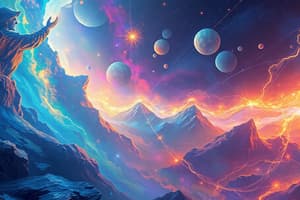Podcast
Questions and Answers
Plasma is the ______ state of matter.
Plasma is the ______ state of matter.
fourth
Plasma exists when a gas is ______, losing its neutrality.
Plasma exists when a gas is ______, losing its neutrality.
ionized
Physical changes affect the ______ or structure of a substance.
Physical changes affect the ______ or structure of a substance.
appearance
Examples of physical changes include ______, boiling, and cutting.
Examples of physical changes include ______, boiling, and cutting.
Chemical changes involve a ______ of the atoms or molecules.
Chemical changes involve a ______ of the atoms or molecules.
Examples of chemical changes include combustion, rusting, and ______.
Examples of chemical changes include combustion, rusting, and ______.
Matter is the physical ______ that surrounds us and is the foundation of all observable phenomena.
Matter is the physical ______ that surrounds us and is the foundation of all observable phenomena.
Matter is composed of elementary particles called ______ and leptons, which combine to form atoms and molecules.
Matter is composed of elementary particles called ______ and leptons, which combine to form atoms and molecules.
Every object resists ______, making it difficult to start moving an object or change its momentum once it is already moving.
Every object resists ______, making it difficult to start moving an object or change its momentum once it is already moving.
Matter in the ______ state typically has a fixed shape and a defined volume.
Matter in the ______ state typically has a fixed shape and a defined volume.
______ have a variable volume and can take the shape of their containers while maintaining a roughly constant density.
______ have a variable volume and can take the shape of their containers while maintaining a roughly constant density.
______ possess neither a fixed shape nor a defined volume.
______ possess neither a fixed shape nor a defined volume.
Flashcards are hidden until you start studying
Study Notes
Matter: Definition, Properties, States, and Identities
Matter is the physical substance that surrounds us and is the foundation of all observable phenomena. It is composed of elementary particles called quarks and leptons, which combine to form atoms and molecules. Matter is characterized by its mass and volume, taking up space in the environment. There are four primary states of matter: solid, liquid, gas, and plasma.
Properties of Matter
Some key properties of matter include:
- Inertia: Every object resists change, making it difficult to start moving an object or change its momentum once it is already moving.
- Gravitational mass: All matter exerts a gravitational force on other matter due to the presence of mass.
States and Transformations of Matter
There are four principal states of matter:
-
Solid: Matter in the solid state typically has a fixed shape and a defined volume. Solids are composed of tightly packed particles, meaning the particles are closely bound and do not move much.
-
Liquid: Liquids have a variable volume and can take the shape of their containers while maintaining a roughly constant density. Liquids consist of loosely packed particles that can move around within the liquid.
-
Gas: Gases possess neither a fixed shape nor a defined volume. They expand to fill the entire volume of their container. Gases are composed of particles packed so loosely that they move almost freely.
-
Plasma: Plasma is the fourth state of matter, existing when a gas is ionized, losing its neutrality. It differs from gases primarily in the behavior of its particles: namely, in the number of charged particles (both positive and negative ions and free electrons) present.
The state of matter is influenced by factors such as temperature and pressure. Materials can transform from one state to another through processes like heating or cooling, compression or expansion, and chemical reactions.
Changes in Matter
Two types of changes can occur in matter: physical and chemical. Physical changes affect the appearance or structure of a substance without altering its chemical makeup. Examples of physical changes include melting, boiling, and cutting. Chemical changes involve a rearrangement of the atoms or molecules themselves, resulting in a completely new substance. Examples of chemical changes include combustion, rusting, and fermentation.
In conclusion, matter is a fascinating substance that exists in various states and can undergo numerous transformations. Understanding its properties and behavior helps us describe and explain the physical world around us.
Studying That Suits You
Use AI to generate personalized quizzes and flashcards to suit your learning preferences.



